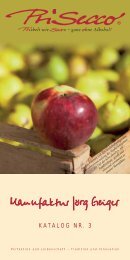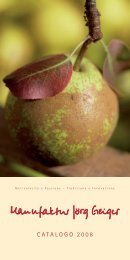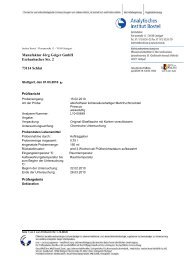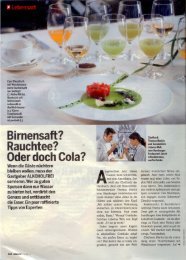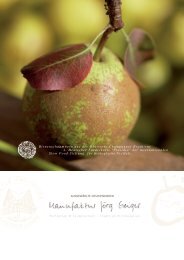CATALOGUE 2009 - Manufaktur Jörg Geiger, Apfelweincocktails ...
CATALOGUE 2009 - Manufaktur Jörg Geiger, Apfelweincocktails ...
CATALOGUE 2009 - Manufaktur Jörg Geiger, Apfelweincocktails ...
You also want an ePaper? Increase the reach of your titles
YUMPU automatically turns print PDFs into web optimized ePapers that Google loves.
<strong>CATALOGUE</strong> <strong>2009</strong><br />
Perfection and Passion – Tradition and Innovation
The Champagne baking pear may<br />
well be an old Württemberger<br />
variety. It originated from an accidental<br />
seedling, as do almost all old<br />
fruit species. In Duke Carl Eugen’s<br />
tree nursery, the Champagne baking<br />
pear was propagated in large numbers<br />
due to its high local importance<br />
so that it could be distributed by the<br />
agricultural patron throughout the<br />
whole of the state of Württemberg.<br />
According to Lucas, around 1850 it<br />
was commonly found on the Filder<br />
elevated plain near Stuttgart, in<br />
the Neckar and Rems valleys and<br />
in many regions of the state. The<br />
tree established itself at medium<br />
altitudes from 300 to 450 m above<br />
sea level, especially in conditions<br />
favourable to creating microclimates<br />
on warmer soils. Today we<br />
find the trees in particular in certain<br />
regions along the Albtrauf, the<br />
northwestern border of the Swabian<br />
Alb mountain range.<br />
Schlat, with its favourable position<br />
for fruit cultivation, has preserved a<br />
vital crop thanks to the attachment of<br />
the local people to their Champagne<br />
baking-pear trees and to the knowledge<br />
of its fruit growers.<br />
The main crop in Schlat is now<br />
between 90 and 120 years old, with<br />
a small part in the middle age range<br />
at 30 years old and newly planted<br />
trees from the last five years that<br />
still have some growing ahead of<br />
them before they begin to deliver<br />
any significant yield after 20 years of<br />
cultivation. A high-standing tree first<br />
completes its natural growth spurt<br />
and only then starts to bear fruit.<br />
This is an example of a tree really<br />
being planted and cultivated for the<br />
next generation, where long-term<br />
management is required.<br />
Our traditional orchards in the<br />
area around the Albvorland, located<br />
below the Albtrauf, are the largest<br />
area of biodiversity north of the<br />
Alps. The outstanding range of<br />
species there is important for all the<br />
ecosystems in central Europe. With<br />
more than 5000 animal and plant<br />
2<br />
species, not counting fungi, lichens<br />
and mosses, this is unique in the<br />
area north of the Alps. The dominant<br />
species of birds found in the traditional<br />
orchard include the little owl,<br />
wryneck, woodchat shrike, green<br />
woodpecker and collared flycatcher.<br />
The traditional orchard is therefore<br />
of the highest importance for the<br />
biodiversity of central Europe,<br />
comparable with the standard olive,<br />
cork and Holm oak tree forests of<br />
southern Europe.<br />
In 2007 the traditional orchards of<br />
the Albtrauf were declared an EU<br />
bird sanctuary.<br />
At the Albtrauf, there is a unique<br />
natural harvest on well-tended<br />
traditional orchards of old fruit<br />
varieties growing on high-standing<br />
trees that produce fruits of<br />
particular taste and quality.<br />
In our fruit workshop, we collect and<br />
cultivate these rare varieties individually<br />
and get the best out of them,<br />
always respecting the traditional<br />
usage, with the best knowledge of<br />
winegrowing and always driven by<br />
those so very “Swabian” virtues of<br />
passion and perfection.<br />
Let yourself be seduced by stimulating<br />
and simple companions and the<br />
aromas of our natural surroundings<br />
in hand-crafted perfection!
<strong>Jörg</strong> <strong>Geiger</strong> was awarded the Innovation<br />
prize of the Steinbeis Foundation<br />
and the Göppingen District Chamber<br />
of Commerce in 1999.<br />
The commitment to reviving old<br />
traditions through innovations, and<br />
thereby preserving and supporting<br />
our cultural landscape with these<br />
giant trees that so influence our<br />
surroundings, was honoured with the<br />
Cultural Landscape prize in 2001.<br />
On 16 May 2007, the first<br />
German “Presidio” promotion<br />
society was recognised by the<br />
International Slow-Food-Foundation<br />
for biological diversity. Promotion<br />
societies are projects with the aim<br />
of protecting small producers and<br />
preserving high-quality hand-crafted<br />
products. Their purpose is to guarantee<br />
a future for food cooperatives by<br />
allowing the producers to join<br />
forces, new market outlets to be<br />
found as well as tastes and bonds<br />
with a territory to be developed.<br />
<strong>Jörg</strong> <strong>Geiger</strong>’s workshop in Schlat is<br />
among twenty chefs and producers<br />
who have rendered outstanding<br />
services to Germany’s top state for<br />
connoisseurs. Accredited by the<br />
state of Baden-Württemberg<br />
with one star at the new Stuttgart<br />
Trade Fair.<br />
Reichenbacher Straße 2<br />
D-73114 Schlat bei Göppingen<br />
Telephone 0 71 61.999 02 24<br />
Fax 0 71 61.999 02 14<br />
info@manufaktur-joerg-geiger.de<br />
www.manufaktur-joerg-geiger.de<br />
Workshop office hours:<br />
Monday, Wednesday, Thursday<br />
and Friday 9 am to 4 pm<br />
Regular deliveries on Wednesdays.<br />
Prices incl. sparkling wine tax and VAT<br />
3
Documentation describes the<br />
manufacture of sparkling wine from<br />
the famous Champagne baking pear<br />
as early as 1760. This “top-rank wine<br />
pear” is first harvested, then washed<br />
and sorted by hand according to<br />
ripeness. The “sweating” that follows<br />
is part of our secret, so that the<br />
luxurious aroma of the pear can<br />
fully develop.<br />
The yellow pear is washed, crushed<br />
and carefully pressed under low<br />
pressure. The sweet juice runs clear<br />
from the press, the tannins from the<br />
pears immediately settle out from<br />
the suspended solids. The sweet juice<br />
remains overnight in the settling<br />
tank before being transferred to<br />
barrels for the first fermentation the<br />
following morning. The slow, aromapreserving<br />
cold fermentation process<br />
carries on for almost three months<br />
in the new cellar. Then, between the<br />
end of December and the beginning<br />
of January after decanting and<br />
filtration, the blending of the cuvées<br />
takes place. This is where experience,<br />
ability and skill come into play. After<br />
the bottling process begins the second<br />
fermentation with the residual<br />
sugar and the Champagne yeast.<br />
Altogether, the sparkling wine<br />
remains in the bottle for at least<br />
nine months until it is shaken and<br />
4<br />
released from the lees at the end of<br />
the traditional bottle fermentation<br />
process.<br />
The result of this unique and painstaking<br />
work is extraordinary refinement<br />
and harmony. The sparkling pear<br />
wine from the Champagne baking<br />
pear presents itself as a fine-bubbled,<br />
long-lasting, intense sparkling wine.<br />
The aroma infatuates with notes of<br />
ripe pears. Then on the palate comes<br />
the big surprise. Containing around<br />
8 % alcohol, the very light and stimulating<br />
sparkling wines are unusually<br />
delicate, rounded and mild.<br />
The sparkling pear wines from the<br />
Champagne baking pear are easily<br />
digestible on account of their<br />
“stomach-friendly” pH value. Firm,<br />
pleasant tannin notes lend structure,<br />
are highly stimulating to the<br />
appetite and also enhance the inner<br />
quality of the antioxidants.<br />
Prof. R. Carle of the Institute of<br />
Food Technology at the University<br />
of Hohenheim, Stuttgart, found that<br />
“enjoying two glasses of sparkling<br />
pear wine from the Champagne<br />
baking pear per day could reduce<br />
the risk of cardiovascular disease”.<br />
Red wines are known for being rich<br />
in tannins, which prevent damage<br />
from occurring to the body’s natural<br />
proteins.<br />
The Champagne baking pear has a<br />
concentration of these materials<br />
that is approx. 10-times higher and<br />
can therefore be regarded as healthpromoting.<br />
“Sparkling pear wine from the<br />
Champagne baking pear is the ideal<br />
accompaniment to an evening for<br />
two.”
Sparkling pear wine<br />
from the<br />
Champagne baking pear<br />
Sparkling pear wine from the<br />
Champagne baking pear is available<br />
in “medium-dry”, “dry”, “brut” and<br />
“extra brut” cuvées.<br />
Medium-dry – broad luxurious fruity<br />
aroma combines with noticeable<br />
sweetness (residual sugar 33g) in the<br />
taste and leaves a full and flattering<br />
impression. Suitable as a sweet<br />
aperitif and as an accompaniment<br />
to dessert.<br />
Dry – expressive, clear pear fruit in<br />
the nose, well integrated, appetitestimulating<br />
tannin structure in a<br />
balanced relationship to the residual<br />
sweetness make this cuvée the ideal<br />
aperitif and the most popular<br />
sparkling solo of the Champagne<br />
baking pear.<br />
Brut – finesse and delicately fruity<br />
aroma – refined acidic structure and<br />
a nutty aromatic middle, typical of<br />
the traditional bottle fermentation<br />
and maturing on fine yeast make<br />
this cuvée an ideal accompaniment<br />
to fried fish, veal, light poultry and<br />
of course as a special, slightly dry<br />
appetiser ...<br />
Extra brut (Selection Bernd Kreis) –<br />
clear and elegant pear aroma with<br />
floral accents – elegant approach<br />
and gentle sparkling of the fine<br />
carbonation. The taste is balanced,<br />
of extraordinary clarity and high<br />
aromatic intensity. Best suited as<br />
an aperitif and an excellent<br />
accompaniment to freshwater fish.<br />
Order<br />
no.<br />
Article % vol.<br />
alcohol<br />
Residual Bottle<br />
sugar cont. size (l)<br />
(grammes)<br />
Price<br />
p. bottle<br />
(€)<br />
Sparkling pear wine from the Champagne baking pear<br />
035 Medium-dry 8.5 33 0.75 13.00<br />
045 Medium-dry, Piccolo 8.5 33 0.20 3.90<br />
001 Dry 8.5 18 0.75 15.90<br />
004 Dry, in wooden case 8.5 18 0.75 19.90<br />
005 Dry, Piccolo 8.5 18 0.20 4.90<br />
006 Dry, magnum 8.5 18 1.50 32.00<br />
009 Dry, Jéroboam 8.5 18 3.00 69.00<br />
031 Brut – tart 8.5 8 0.75 16.90<br />
040 Extra Brut – Selection Bernd Kreis 8.5 4 0.75 20.00<br />
700 Save the Champagne baking pear Mixed case 29.90<br />
5
Vins de fruits mousseux partiellement fermentés, produits à partir<br />
d’anciennes variétés de pommes et de poires provenant de vergers<br />
à hautes tiges de plus de 100 ans.<br />
Vins de fruits mousseux partiellement<br />
fermentés, produits à partir d’anciennes<br />
variétés de pommes et de poires provenant<br />
de vergers à hautes tiges de plus<br />
de 100 ans.<br />
Ces grands arbres qui ont vu passer plusieurs<br />
générations d’hommes nous amènent<br />
à témoigner un profond respect<br />
pour la nature et incitent à la réflexion.<br />
Les Souabes étant connus pour leur<br />
esprit inventif, il n’est pas surprenant<br />
qu’ils aient toujours su exploiter au<br />
mieux les richesses de leur terroir,<br />
comme nous le prouve une ancienne<br />
recette que nous faisons renaître en lui<br />
conservant son nom d’origine «Schwäbischer<br />
Cider» (cidre souabe), élaborée à<br />
partir d’une belle composition de fruits<br />
provenant de nos vergers séculaires.<br />
Au grand étonnement des profanes, ces<br />
anciennes variétés de pommes n’atteignent<br />
leur maturité qu’après un certain<br />
temps de post-maturation et les poires<br />
fraîchement cueillies sont tellement âpres,<br />
«que même les bêtes n’en voudraient pas».<br />
Partant du principe que tout vient à point<br />
à qui sait attendre, nous trions toutes les<br />
poires dans notre manufacture et les laissons<br />
«macérer» pendant des durées variables<br />
dépendant de leur maturité initiale,<br />
pour permettre aux arômes de se dévelop-<br />
Réf. Article % vol.<br />
alcool<br />
Sucre<br />
résiduel<br />
(grammes)<br />
Bouteille<br />
(litres)<br />
Prixpar<br />
bout.<br />
€<br />
350 Schwäbischer Cider doux 4,5 65 0,75 7,00<br />
360 Schwäbischer Cider brut 6,5 12 0,75 7,00<br />
6<br />
per pleinement, les acides tanniques<br />
conférant ici une structure et un corps à<br />
la fois puissant et harmonieux.<br />
Le jus fraîchement extrait des fruits<br />
repose ensuite toute une nuit, afin d’obtenir<br />
une clarification naturelle avant<br />
le soutirage. La fermentation s’effectue<br />
directement en cuve close. Au moment<br />
opportun, elle est interrompue par un<br />
refroidissement rapide, qui est non sans<br />
rappeler le froid intense des hivers d’antan.<br />
Cette opération se fait plus tôt pour<br />
un cidre «doux», plus tardivement pour<br />
un cidre «brut». Elle est ensuite suivie<br />
d’une longue maturation avec ajout de<br />
levures.<br />
Le «doux» est un cidre harmonieux, dont<br />
la faible acidité agrémentera parfaitement<br />
les belles soirées d’été. Il ne faudra<br />
toutefois pas oublier d’en tenir une<br />
seconde bouteille en réserve au frais!<br />
Il accompagne parfaitement les salades<br />
croquantes garnies d’une vinaigrette<br />
douce et fruitée, les fromages frais de<br />
chèvre et de brebis ou encore les desserts<br />
à base de fromage blanc ou de yaourt.<br />
Le «brut» se caractérise par un nez aux<br />
nuances fortes, une faible acidité et une<br />
douce astringence. Il accompagne particulièrement<br />
bien les gratins, les plats à base<br />
de pommes de terre ainsi que les asperges.
Des boissons rafraîchissants hors du commun<br />
Un must pour tous les apéritifs...<br />
Nos fruits sont issus des vergers<br />
traditionnels à hautes tiges, typiques du<br />
paysage bordant la réserve ornithologique<br />
s’étendant au pied du jura souabe.<br />
Fruits rouges<br />
...Un nez dominé par la griotte et<br />
le cassis, en bouche, les abondantes<br />
saveurs de sureau et du coing mariées<br />
à une pointe d’acidité de limette<br />
créent un goût dont l’intensité réveille<br />
l’ensemble des papilles gustatives.<br />
Fruits blancs<br />
Raisin, pêche et citron multiplient<br />
les sensations en bouche. Des fleurs<br />
de sureau cueillies à la main, des<br />
herbes aromatiques et médicinales<br />
de choix ainsi que d’agréables épices<br />
confèrent une densité et un jeu<br />
d’arômes séduisant. Ayant l’aspect<br />
d’un mousseux, cette boisson fruitée<br />
stimule agréablement les sens.<br />
Réf. Article % vol.<br />
alcool<br />
Sucre<br />
résiduel<br />
(grammes)<br />
Bouteille<br />
(litres)<br />
Prixpar<br />
bout.<br />
€<br />
200 Cocktail sans alcool, fruits rouges 0,1 120 0,75 6,90<br />
210 Cocktail sans alcool, fruits blancs 0,1 124 0,75 7,20<br />
Des apéritifs adaptés à la saison<br />
La <strong>Manufaktur</strong> <strong>Jörg</strong> <strong>Geiger</strong> vous<br />
propose également un grand choix<br />
d’autres boissons gourmandes.<br />
La variété de pommes « Bittenfelder » à<br />
maturation tardive est à la base de ce<br />
vin de pomme rafraîchissant au goût<br />
amer. Cueillis avec soin, les fruits sont<br />
sélectionnés et doucement pressés, le<br />
moût étant ensuite fermenté à froid.<br />
Fleurs de sureau cueillies à la main et<br />
agréable mélange aigre-doux de la<br />
pomme se combinent pour donner<br />
une boisson aux arômes floraux d’une<br />
fraîcheur séduisante, idéale pour les<br />
apéros du début de l’été.<br />
Vin de pommes « Boskoop » et cassis<br />
frais, unis en cuve pendant plusieurs<br />
jours puis mis en bouteille au moment<br />
où il devient pétillant. Ceci permet aux<br />
arômes riches et expressifs du cassis<br />
de s’épanouir, le tout étant relevé par<br />
une élégante amertume.<br />
Réf. Article % vol.<br />
alcool<br />
Sucre<br />
résiduel<br />
(grammes)<br />
Bouteille<br />
(litres)<br />
Prixpar<br />
bout.<br />
€<br />
102 Sommernachts-Traum 5,5 28 0,75 6,90<br />
100 Schwäbischer Kir 5,5 35 0,75 6,80<br />
7
Le plaisir conjugué<br />
à la passion<br />
Notre passion pour les spécialités du<br />
terroir, produites selon des traditions<br />
ancestrales, nous a amenés au cours<br />
de l’hiver 2006/2007 à faire revivre<br />
un produit particulièrement laborieux<br />
à fabriquer, dont seule la saveur<br />
inégalée justifie le travail investi.<br />
Possédant une personnalité unique,<br />
notre EisApfel offrira aux gourmands<br />
un véritable feu d’artifice des sens.<br />
Vin de pommes sélectionnées,<br />
partiellement fermenté.<br />
Un produit au caractère particulier,<br />
issu du terroir de l’Albvorland<br />
Tard en hiver, les pommiers à hautes<br />
tiges des vergers traditionnels du<br />
Wurtemberg chargés de pommes<br />
rouge et jaune vif de l’ancienne<br />
variété «Bittenfelder Sämling» sont<br />
un spectacle frappant.<br />
Pendant une année entière, les pommes<br />
se sont considérablement enrichies de<br />
sucre et ont atteint une acidité élevée.<br />
Les nuits de gelée entraînent une forte<br />
concentration des arômes, le froid faisant<br />
geler l’eau, de sorte que seul le<br />
nectar concentré obtenu sera fermenté<br />
à froid, un procédé permettant de préserver<br />
les arômes.<br />
Grande suavité et belle acidité caractérisent<br />
ce liquide ambre de façon<br />
toute particulière. En nez, l’EisApfel<br />
séduit par ses riches notes de fruits<br />
mûrs où se marient la pomme, le fruit<br />
de la passion et la banane. La bouche,<br />
surprenante, rappelle la pomme cuite<br />
au four et les agrumes.<br />
L’EisApfel n’a pas besoin d’alcool<br />
pour rehausser son goût. Avec un titre<br />
alcoométrique d’à peine 3,7% vol., il<br />
fait un superbe digestif rafraîchissant,<br />
se substituant sans peine à un spiritueux<br />
même après un repas copieux.<br />
Accompagne les desserts à base<br />
d’agrumes ou de fruit<br />
de la passion, les<br />
desserts au four, le<br />
chocolat noir et le<br />
fromage de chèvre.<br />
Bien entendu,<br />
l’EisApfel se boit<br />
également en<br />
apéro. Dégusté à<br />
petites gorgées,<br />
sa douceur prononcée,légèrement<br />
acidulée<br />
est excellente pour<br />
ouvrir l’appétit.<br />
Disponible dans une boîte en bois<br />
exclusive, avec couvercle à charnière<br />
orné d’une inscription et feuillet<br />
descriptif, il s’offre parfaitement en<br />
cadeau, non seulement pendant la<br />
période des fêtes de fin d’année.<br />
Réf. Article % vol.<br />
alcool<br />
Sucre<br />
résiduel<br />
(grammes)<br />
Bouteille<br />
(litres)<br />
Prixpar<br />
bout.<br />
€<br />
450 «EisApfel» cidre partiellement fermenté 3,7 220 0,375 23,90<br />
460 «EisApfel» dans une boîte en bois 3,7 220 0,375 29,00



